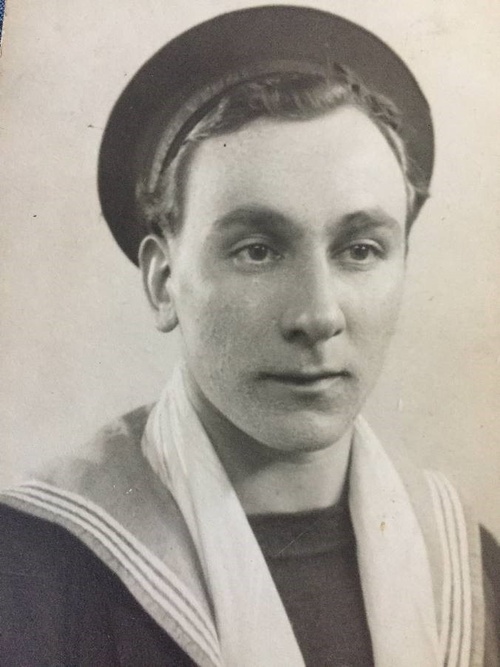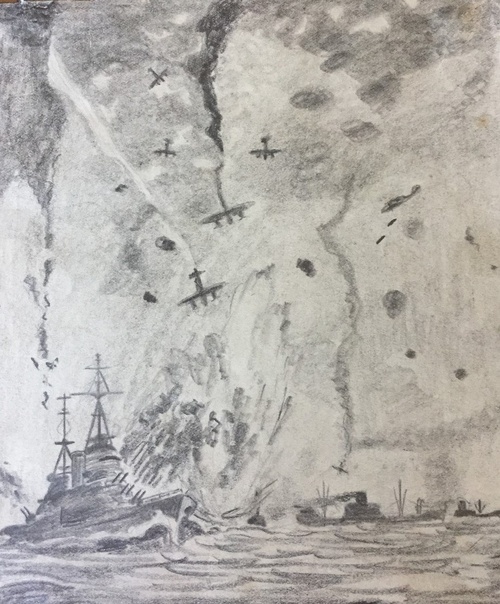Auction: 22003 - Orders, Decorations and Medals
Lot: 403
A well-documented Second World War Arctic convoys group of six awarded to Signalman G. F. Siddall, Royal Navy, who shared in the trials and tribulations of PQ-18 in September 1942
A talented amateur artist, he captured the horrors of the enemy's 'Golden Comb' attacks, when the sky was so thick with enemy aircraft that one witness likened them to 'a cloud of phantom locusts.' Better still, several of his dramatic wartime sketches form part of an accompanying archive of original documentation
1939-45 Star; Atlantic Star; Arctic Star, in its named box of issue; Italy Star; War Medal 1939-45; U.S.S.R., 40th Anniversary Medal 1945-85, together with official 'Arctic Emblem' lapel badge, good very fine or better (7)
George Frederick Siddall was born in Salford, Lancashire on 29 June 1921 and entered the Royal Navy as an Ordinary Signalman in August 1941. Having then attended various training establishments, he joined the Halcyon class minesweeper H.M.S. Gleaner in June 1942 and remained similarly employed until May 1943.
Arctic run - QP-18
Having been refitted as a minesweeper and undertaken her 'working up' trials at Tobermory and Oban, Gleaner departed for Scapa in preparation for the vital Arctic convoy QP-18. Having rendezvoused with her fellow escorts off Iceland on 7 September 1942, she took up a screening station on the port side of the convoy.
She subsequently endured all the horrors of the 'Golden Comb' attack unleashed by enemy aircraft on the 13th, an attack enacted by 44 torpedo bombers which sank eight merchantmen for a loss of five aircraft. One Ju. 88 attacked Gleaner out of the clouds but its bombs fell wide to starboard, and her Oerlikon gunners claimed to have obtained hits on their adversary.
An inkling of the ferocity of this 'Golden Comb' attack is to be found in the following eye-witness account by John Manners, the First Lieutenant of H.M.S. Eskimo:
'Suddenly there was one of the most horrifying sights of the war. Along the whole horizon were aircraft flying just above the waves wing tip to wing tip and below radar cover. This was the German 'Golden Comb' attack in which all the planes released two torpedoes each at the same time. Records show there were forty-two Heinkel torpedo bombers and a number of Junkers 88s.
Everything was happening - as soon as they were seen the commodore of the convoy [PQ-18] ordered an emergency turn away in order to comb the tracks of the torpedoes but unfortunately the two starboard columns did not comply. Like all the others Eskimo put the helm hard over and increased speed, which made the ship list and heel over. These frantic manoeuvres made it impossible for any accurate gunfire. However, every ship blasted off with everything and the air was thick with bullets.
The Eskimo was in the starboard column of the screen and this menacing swarm passed a few feet overhead and as the aircraft were travelling at about 250 miles an hour they were gone before you could say 'Jack Robinson'. We were not their prime target and shortly after passing us they released no less than 110 torpedoes.
In no time eight ships were hit, some sank at once and in one case, there was a gigantic explosion sending a column of black smoke vertically upwards and the ship vanished completely.
The barrage that was fired at the attackers was terrific, but according to German records only five planes were shot down though many more must have been damaged … '
The following day the convoy was again subjected to heavy air attack, one bomb falling 50 yards off Gleaner's starboard beam. In retaliation her gunners claimed hits on the offending Ju. 88, in addition to three torpedo carrying bombers.
On the 15th and 16th, Gleaner obtained significant RDF contacts which led to destroyer depth charge attacks, whilst on the 18th she came under attack by enemy aircraft at the mouth of the White Sea. Having then reached Archangel and refuelled at the Kola Inlet, Gleaner and her consort Harrier were placed under Russian command in October 1942, operating out of Tokanka.
Three of her crew were subsequently mentioned in despatches for their gallantry and example under enemy air attack.
Finally, at the end of December 1942, Gleaner joined convoy RA. 51 for the return trip to the U.K., arriving at Loch Ewe on 11 January 1943.
Subsequent career
Having departed Gleaner at the end of May 1943, Siddall attended the shore establishment Drake, where he gained advancement to Signalman.
He then returned to sea in the destroyer Quantock in January 1944 and remained likewise employed until September 1945, in which period she was actively employed in the Adriatic. He was released 'Class A' in March 1946.
Sold with the following archive of original documentation and artwork:
(i)
A rare archive of wartime artwork, comprising six original pencil sketches, all signed by the recipient, depicting scenes on the Artic run in 1942, the border titles reading: 'The final high-level attack'; 'Dive bombing attack on escort and convoy'; 'low-level attack by torpedo carrying aircraft'; 'Mines are cleared by British minesweepers'; 'Submarine attack on H.M.S. Scylla - seen from a British aircraft'; and 'Dive-bombing attack', the whole well-executed, action-packed and worthy of full and proper display; see sample illustrations.
(ii)
The recipient's Certificate of Service, together with his Signal History Sheet and Admiralty Order of Release, this latter dated 22 January 1946.
(iii)
Ministry of Defence forwarding letter for the recipient's Arctic Star, as claimed by his family in April 2015; together with similar notifications for his 'Arctic Emblem' lapel badge and certificate and letter in respect of his Soviet 40th Anniversary Medal.
(iv)
The recipient's Arctic Circle 'crossing the line' certificate, dated aboard H.M.S. Gleaner on 8 September 1942.
(v)
Half a dozen wartime photographs / postcards, including a portrait of the recipient in uniform.
Subject to 20% VAT on Buyer’s Premium. For more information please view Terms and Conditions for Buyers.
Sold for
£1,600
Starting price
£520













